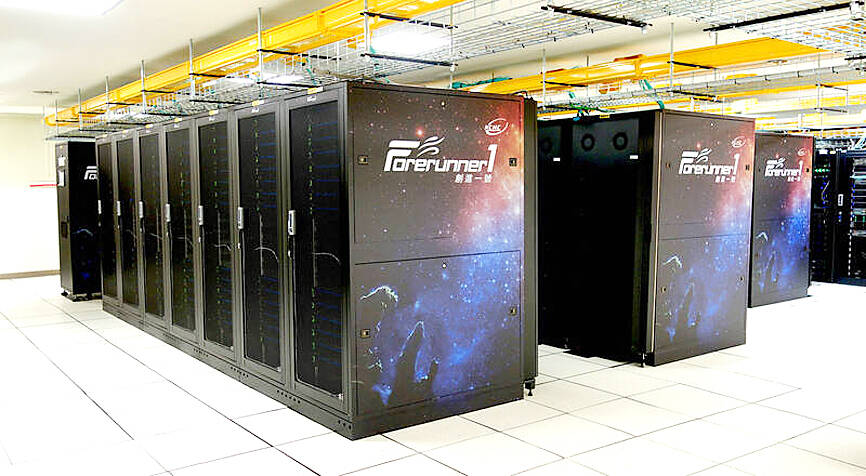The supercomputer Forerunner 1 (創進一號) has officially been launched for deployment in fields that require high-performance computing, including weather forecasts, astrophysics simulations, and engineering design and simulations, the National Center for High-Performance Computing said yesterday.
The center last year began building the next-generation supercomputer at its office in Tainan to replace the Taiwania 1 (台灣杉一號), which has been retired.
Forerunner 1 features 62,496 computing cores, with an overall performance capacity of up to 3.5 petaflops and 9.2 petabytes of storage, the center said.

Photo courtesy of the National Center for High-Performance Computing
For the first time, 40 ARM architecture computing nodes have been installed in the new supercomputer, allowing users to conduct preliminary heterogeneous architecture testing as a reference for the center when it builds new supercomputers in the future, it said.
The center has built supercomputers of different architectures to cope with large-scale scientific and artificial intelligence (AI) projects, it said.
The CPU-based Forerunner 1 is suitable for various high-performance computing tasks, including weather forecasts, astrophysics simulations, molecular model simulations, and engineering design and simulation.
Taiwania 1 was built in 2017 with a performance capacity of 1.7 petaflops, center director-general Chang Chau-lyan (張朝亮) said in a statement.
“With the rapid development of global high-performance computing and artificial intelligence, the improvement of computing power is directly related to the nation’s technological competitiveness,” Chang said.
“The center will gradually establish more powerful computing infrastructure,” he said.
The center is scheduled to complete the construction of 16 petaflops of graphics processing unit-based computing power by the end of this year to meet the needs of AI-related research and application, such as large language models, Chang said.
“We are also aiming to upgrade our computing power to 200 to 300 petaflops by 2028 to further enhance Taiwan’s competitiveness in global technology research and development,” he said.
During the pilot test, Forerunner 1 demonstrated excellent performance in many fields, including astrophysics, fluid mechanics, atmospheric science, high-energy physics and materials computing, the center said.
With the use of Forerunner 1, Academia Sinica’s astrophysics research has increased its computing speed by 5.3 times, while National Chung Hsing University and National Cheng Kung University have significantly increased the scale of fluid dynamics calculations and simulations, reducing the calculation time for billion-level ultra-fine grids from several months to 40 hours, the center said.
The next-generation supercomputer has helped elevate National Taiwan University’s air-sea coupling model test efficiency, which was 80 percent higher than that conducted by Taiwania 3, the center said.
Research on quantum chemistry and materials calculations has also been significantly accelerated, it said.

The US government has signed defense cooperation agreements with Japan and the Philippines to boost the deterrence capabilities of countries in the first island chain, a report by the National Security Bureau (NSB) showed. The main countries on the first island chain include the two nations and Taiwan. The bureau is to present the report at a meeting of the legislature’s Foreign Affairs and National Defense Committee tomorrow. The US military has deployed Typhon missile systems to Japan’s Yamaguchi Prefecture and Zambales province in the Philippines during their joint military exercises. It has also installed NMESIS anti-ship systems in Japan’s Okinawa

TRAGEDY STRIKES TAIPEI: The suspect died after falling off a building after he threw smoke grenades into Taipei Main Station and went on a killing spree in Zhongshan A 27-year-old suspect allegedly threw smoke grenades in Taipei Main Station and then proceeded to Zhongshan MRT Station in a random killing spree that resulted in the death of the suspect and two other civilians, and seven injured, including one in critical condition, as of press time last night. The suspect, identified as a man surnamed Chang Wen (張文), allegedly began the attack at Taipei Main Station, the Taipei Fire Department said, adding that it received a report at 5:24pm that smoke grenades had been thrown in the station. One man in his 50s was rushed to hospital after a cardiac arrest

‘WIN-WIN’: The Philippines, and central and eastern European countries are important potential drone cooperation partners, Minister of Foreign Affairs Lin Chia-lung said Minister of Foreign Affairs Lin Chia-lung (林佳龍) in an interview published yesterday confirmed that there are joint ventures between Taiwan and Poland in the drone industry. Lin made the remark in an exclusive interview with the Chinese-language Liberty Times (the Taipei Times’ sister paper). The government-backed Taiwan Excellence Drone International Business Opportunities Alliance and the Polish Chamber of Unmanned Systems on Wednesday last week signed a memorandum of understanding in Poland to develop a “non-China” supply chain for drones and work together on key technologies. Asked if Taiwan prioritized Poland among central and eastern European countries in drone collaboration, Lin

ON ALERT: Taiwan’s partners would issue warnings if China attempted to use Interpol to target Taiwanese, and the global body has mechanisms to prevent it, an official said China has stationed two to four people specializing in Taiwan affairs at its embassies in several democratic countries to monitor and harass Taiwanese, actions that the host nations would not tolerate, National Security Bureau (NSB) Director-General Tsai Ming-yen (蔡明彥) said yesterday. Tsai made the comments at a meeting of the legislature’s Foreign Affairs and National Defense Committee, which asked him and Minister of National Defense Wellington Koo (顧立雄) to report on potential conflicts in the Taiwan Strait and military preparedness. Democratic Progressive Party (DPP) Legislator Michelle Lin (林楚茵) expressed concern that Beijing has posted personnel from China’s Taiwan Affairs Office to its